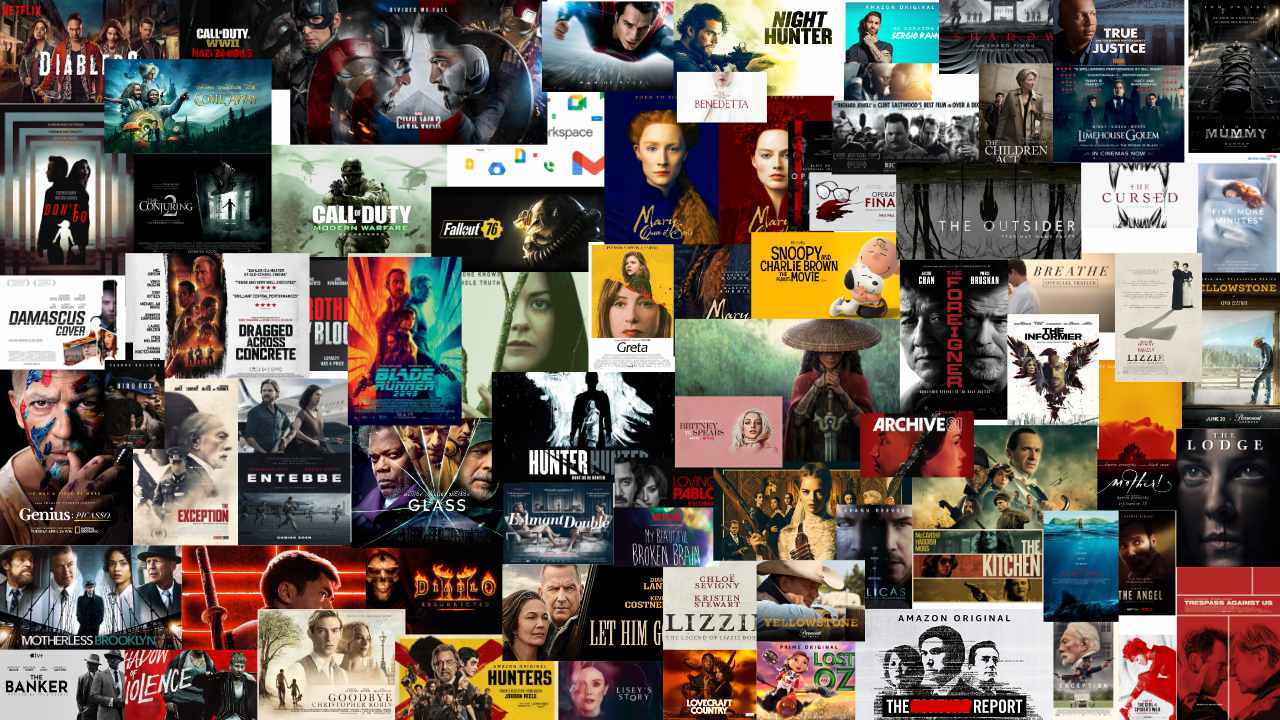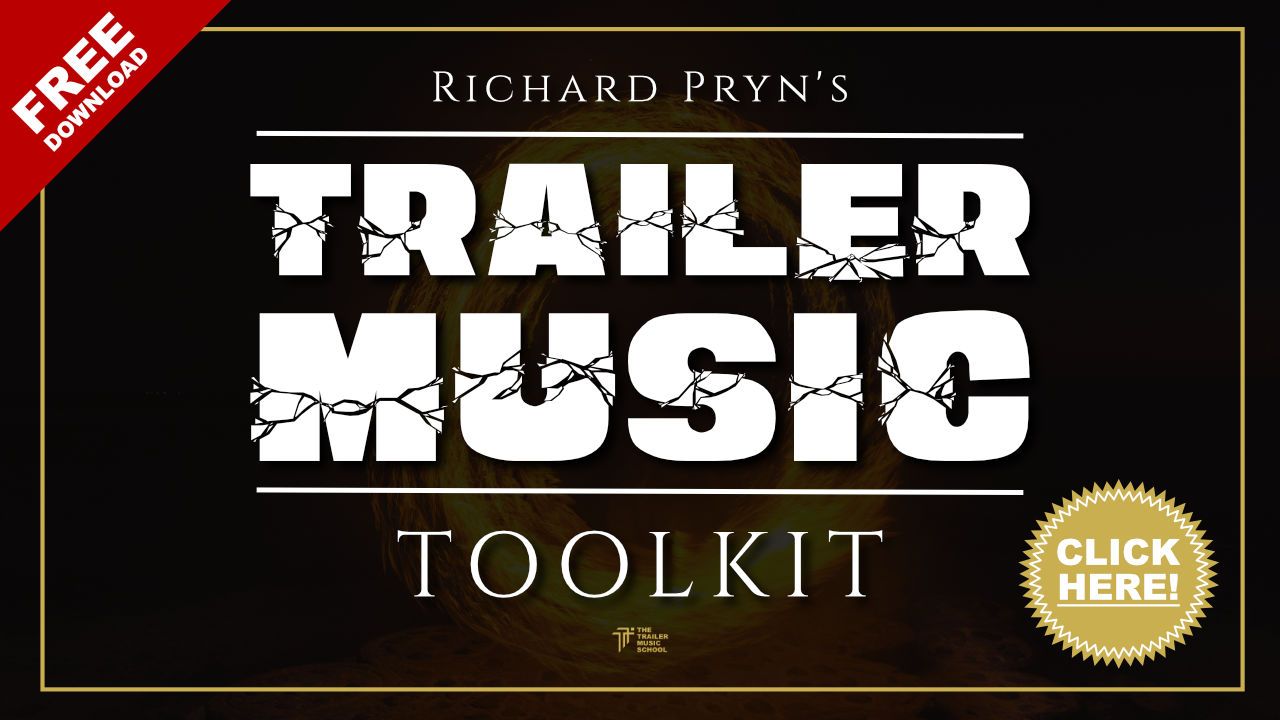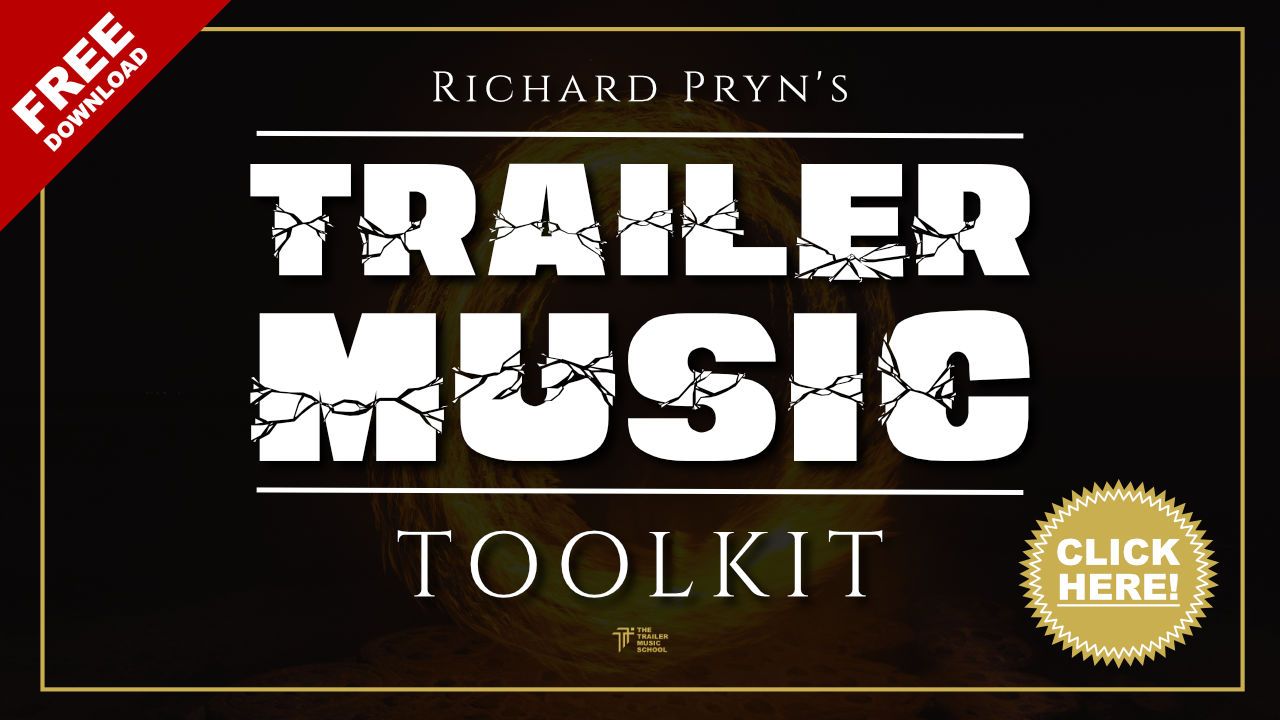In this article, I show you how to make trailer music.
I love trailer music and I love teaching it too.
Looking over the free content on "how to write trailer music", I feel that quite a few basic elements are missing.
So I thought I would create a post that details the most important elements of making trailer music and how I have done it successfully for over a decade.
What makes me suitable to teach you how to make trailer music?
I have been writing trailer music for over 10 years now. I have hundreds of trailers and multiple awards for my work.
I regularly get my work placed on trailers in many different styles: neoclassical, action sound design, dramatic piano, acoustic, beats, etc. And I have earned over 7 figures in the process.

I have also been teaching aspiring composers how to write trailer music since 2017 and am now seeing those early students become full-time trailer music composers. This Vikings: Valhalla trailer features music by one of my first students Espen.
Let me show you the most important aspects of writing trailer music that will help you make the trailer music you want.
Tips for Success in Trailer Music
Write more music, faster
If you want to become successful in Trailer music, you need to understand that it is a numbers game - the more music you produce that gets published then the greater the chance that you will land a placement.
When you do land a placement, it can range in fees from around $1000 to upwards of $40,000 (this is after the 50/50 split between you as the writer and the publisher).
Improve your workflow
This is why one of the biggest aspects of my success was not my talent; it was my speed and mindset. I am able to write music of a high quality quickly and with little mental friction.
This is in part to my mantra, "Done is better than perfect", but also down to the things I teach in my courses: improved workflow, mastering structure, and not overthinking your musical choices.
What's "good" is subjective
Some of my biggest placements were the tracks that I did not think were my best. In fact, some of them I was a little embarrassed by (for one reason or another).
What this means is, you are not the final judge on quality. You could think a track is not good, and yet your publisher could love it.
This is why you must always submit the work, whether you think it's your best or not.
What is Trailer Music (and how to stay in vogue)
Before we get into the finer details of writing trailer music, I wanted to clear something up: Trailer music is any music produced for use in trailers. It is not just epic-orchestral music.
Trailer music can be Hip Hop, EDM, Nu Metal, etc. As long as it has been produced for trailers, then it is trailer music.
The goal for you is to write music that not only your publisher wants to pitch, but that the trailer houses want to license.
As trailer music relies heavily on trends, keeping up with the latest trailers and trailer music releases will also mean that you are up to date with what the publishers and trailer houses want. Greatly improving your chances of landing a trailer.
This is advice I almost always give my mentor students and members of my Composer Academy: research CURRENT trends in the niches you are interested in and absorb those into your musical palette.

Get my FREE Trailer Music Toolkit
It contains all the One-shots you need to sketch a complete track and the hugely popular Perfect Trailer Music Cue Blueprint PDF.
What Makes Trailer Music Sound Like Trailer Music?
Now you know that "Trailer Music" is any kind of music that is produced for trailers it begs the question, "What makes it sound like trailer music then?"
Enter the word "Trailerization" or "Trailerisation". This is the process of taking a piece of non-trailer music and making it fit the world of trailers.
The reason I am introducing you to this concept is that it is the key to understanding how to turn any musical genre into trailer music.
Trailerisation involves:
- Making the structure of the track fit the 3 or 4-act structure of movie trailers
- Adding in cinematic trailer hits
- Adding in Cinematic transitions
These three elements are crucial to trailer music across the board and are what make trailer music sound the way it does and complement trailers the way it does.
Trailer Music Structure
Let's dive into structuring your music to fit the "trailer music structure" because if you learn to do this right, then it could mean the difference between your track getting a placement or not.
Trailer music is traditionally split up into 3 Acts to fit the narrative structure of a film. Each act has its own purpose and reason for functioning the way it does.
In between each act, there is almost always a stopdown. These essentially came about because trailer editors wanted to emphasise the important parts of the story within the trailer. The track builds up to a climax at the end of each act and drops to silence (or near silence).
Act 1 - set the scene
Act 1 sets the scene of the trailer of the character(s) in their life before they are thrown into the story.
Basically, this is their life before it all changed; before he met the girl, or before they moved into a haunted house, or before the world almost ended, etc. Musically, Act One reflects that, but also builds into the next act and sometimes hints at what is to come in the rest of the trailer.
You can see in the first 20 seconds of this trailer how we meet the main character in her world - the music is setting the scene; it's cool, it's got swagger and confidence, and it builds to a drop
Act 2 - drive the story
Act 2 is the point in the story when the main character's world starts to change. For example, Alice enters Wonderland, Uncle Owen buys C3PO and R2D2, and when Harry starts getting letters from Hogwarts. Musically, we bring in elements to reflect that, like driving string patterns, pulsing bass lines, big brass sections, and rolling percussion, etc.
You can see in this amazing trailer (with Mark Petrie's awesome track Redshift) how we are thrown into Act 2 with driving strings, huge hits and big brass and strings. The world is changing and the music lets us know.
Act 3 - Bring the climax
Then we have Act 3. When our characters are thrown into facing their problems, struggling against all odds, with very little chance of success. Or at least that is what the trailer makes us think.
Musically, Act 3 needs to sound massive, filled with drive, tension, impact and emotion - it has to feel like the world is in the balance.
As you can hear, this third act is full of emotion, power, and impact - it makes you want to get up and fight for what is right. More importantly, it makes you want to see the movie 🤣
Editor's Ear Candy
In my interview with Chris Davey, he mentioned something he called "ear candy".
These are the interesting elements that happen between the acts that give the editor interesting points to cut to. It can be small stopdowns, signature sounds, cinematic effects, and found sounds.
The world is your oyster with these elements, but the real trick is not to throw too many in, or your track will lose flow or sound muddled. I like to think of them in the same vein as drum fills - a well-placed fill is better than a few badly placed ones.
Remember, the goal is to write licenseable music, so having some extra elements for the editor just makes your track more useful - this cannot be overlooked.
My favourite form of ear candy is signature sounds that I record and create myself, like you can hear in my music, used in the trailer for
On the shoulders of Giants
If you are feeling overwhelmed by all this talk of acts, stopdowns and structure, then the simple thing is to "copy" the structure of existing trailers.
I do not mean to copy the music. I mean, use the trailer and its music as a template for the acts; how long is each act, is there a 4th act, how long are the stop downs, are there any other edit points, etc.
What this will do is get you used to the flow of a trailer and how best to use those interesting bits of "ear candy" to make your track more usable and more licensable.
Using Trailer Hits
Trailer hits are an integral part of all trailer music. They can take a piece of romantic music, or lofi hip hop or even simple drones and make it feel like trailer music.
They bring the weight, scale, and impact that we need in trailer music to match the often larger-than-life and/or otherworldly visuals.
Not only do they act as veritable explosions in our music, but they also serve to accent interesting parts of our music and give the trailer music editor something clear to cut to.
You might be thinking, "Hold on Rich, you haven't shown me how to write trailer music yet" and this is where we start.
The first thing we are going to do is to sketch out our trailer music track. This works to outline the structure of the cue but also to alleviate the age-old problem of not being able to finish a piece of music.
I created this tutorial to show how you can use trailer hits to sketch out your entire track and speed up your writing process as a result.
Cinematic Transitions
Cinematic effects are those whooshes, swooshes and swishes that editors use to accent changes in the edit, like mood, scene, or pacing. Because of their use by editors, it has meant that composers have started to use them in their tracks to give their music a cinematic feel and give the editor something to work with more easily.
As a composer, we would place these sounds in a few places in our track:
- At the start and end of an act
- Every 2/4/8 bars (making sure that it doesn't sound repetitive and fits into the track)
- To emphasise the entrance of a new musical element, arpeggio, rhythm, melody or chord sequence
Signature Sounds
For one of my trailer music albums, I hired my friend SImon Haglund to create some dino-inspired signature sounds. He created this great tutorial showing how he did it.
This is one of those things that has been around for ages but has only become a buzzword in the last few years.
Signature sounds do what they say on the tin; they supply a sonic "signature" to the track so that it has its own unique identity and can more easily stand out from all the other tracks.
As more and more trailer music gets created, it is becoming more and more important for composers (and their music) to stand out from the crowd.
My simplest and most easily accessible advice for creating signature sounds is to go out and record your own. Nothing fancy, just a sound source and a microphone. This at least ensures that you start with a unique recording that you can then manipulate in your DAW.
Chord Progressions (Don't overthink them)
When I started writing my own music, I would approach each new song like it were going to be something nobody had ever heard before.
All this did was create a huge amount of stress when writing new music.
As I got more experienced, I quickly realised that trying to find "the perfect" chord progression was a fruitless waste of time.
I could instead choose one of the many effective, tried and tested chord progressions and just get on with it. After all, Beethoven didn't turn his nose up at an I-V progression, now did he?
My advice to you is to make 2 quick and simple decisions:
- The tonality you are going to choose - major or minor?
- Choose one of the many progressions in your chosen tonality
If you have chosen a major key, then you can choose from one of these popular trailer music major progressions:
- I - IV | (One of my favourites) In the key of C major, that would be – C - F
- I - iv - IV - V | (Hugely popular) In the key of C, that would be – C - Am - F - G
- I - iii | (slightly sad sounding) In the key of C major, that would be — C - Em
If you have chosen a minor key, then you can choose from one of these popular trailer music minor progressions:
- i - VI | In the key of Cm, that would be – Cm - Ab
- i - VII - VI - V | In the key of Cm, that would be – Cm - Bb - Ab - G
- i - VI - v | In the key of Cm, that would be – Cm - Ab - Fm
Creating Drive & Urgency
This is one of the most important elements in trailer music and one that is often overlooked. Without the drive and urgency, your music will not push the tension and narrative of the trailer, so it will not get used.
The great news is that it is actually really easy to create drive and urgency with pulses and patterns.
A simple single pulse played on any instrument will drive your track forward with very little effort on your part.
If however, a pulse is not appropriate in your track, then creating a pattern/ostinato instead will do the job nicely. This is actually my preferred way to create drive and urgency because you can include different intervals in your pattern that will create their own harmonic tension, as well as the pace the pattern has set.
Sub Genres of Trailer Music
This is one of the most misunderstood things about trailer music: that all trailer music is epic orchestral. Ehhhh?!
Trailer music is any music that is written for specific use in movie trailers.
You can have soft acoustic trailer music, drone trailer music, trailerised EDM, and trailerised string quartets. You name it, as long as it has the elements discussed in this article and has been written for trailers, then it is trailer music.
This is how I have managed to make a great living writing trailer music because I diversified into multiple subgenres in trailer music: horror, thriller, family adventure, action, romance, etc.
If you are interested in learning more about trailer music, then you should sign up for my Trailer Music Course and kick-start your career in trailer music. Or if you want to learn how to write in all the subgenres I have had success in, then check out my Ultimate Trailer Music Course Bundle.

How do you know if you are any good?
It's all very good, locking yourself away and making the most amazing trailer music in the world ever (or at least, pretty good music at the least), but how do you know if you are actually any good?
This has been one of the biggest reasons my students sign up for my community or mentor program: to have an actual professional giving them feedback and advice.
You can get this from places like Cody Still's Facebook group, The Trailer Music Composers' Support Group. It is one of the best places to get advice and help with trailer music.
Don't get feedback from your friends or family. Well, you can, but don't take it as professional advice. You really do need someone with experience to guide you.
The other option of course, is to get work with a trailer music publisher and start getting feedback on real-life briefs - my preferred way.






